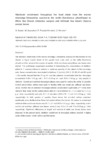Mostrar o rexistro simple do ítem
Riboflavin enrichment throughout the food chain from the marine microalga Tetraselmis suecica to the rotifer Brachionus plicatilis and to White Sea Bream (Diplodus sargus) and Gilthead Sea bream (Sparus aurata) larvae
| dc.contributor.author | Souto Alonso, Maria | |
| dc.contributor.author | Saavedra, M. | |
| dc.contributor.author | Pousao-Ferreira, P. | |
| dc.contributor.author | Herrero, Concepción | |
| dc.date.accessioned | 2014-09-09T10:19:14Z | |
| dc.date.available | 2014-09-09T10:19:14Z | |
| dc.date.issued | 2008-10 | |
| dc.identifier.citation | Souto M, Saavedra M, Pousão-Ferreira P, Herrero C. Riboflavin enrichment throughout the food chain from the marine microalga Tetraselmis suecica to the rotifer Brachionus plicatilis and to White Sea Bream (Diplodus sargus) and Gilthead Sea bream (Sparus aurata) larvae. Aquaculture. 2008;283(1-4):128-33 | es_ES |
| dc.identifier.uri | http://hdl.handle.net/2183/12494 | |
| dc.description.abstract | [Abstract]The riboflavin enrichment of the marine microalga Tetraselmis suecica and the transfer of this vitamin to higher trophic levels of the aquatic food chain such as the rotifer Brachionus plicatilis and the larvae of two species of sparids: white sea bream and gilthead sea bream were studied. The preliminary experiment consisted of determining the concentration of riboflavin added to T. suecica cultures to achieve a maximum quantity of this vitamin in the microalgal cells. Seven concentrations were tested in triplicate: 0 (control), 2.5, 5, 10, 20, 40 and 80 ng ml− 1; the results showed that the 10 ng ml− 1 was the optimum concentration that the microalgae accumulated 4.29 ± 0.19 pg cell− 1, 21.2 ± 0.35 ng ml− 1 and 19.4 ± 0.56 μg g− 1 (dry weight) of riboflavin. Control and enriched microalgal cultures were used for feeding the rotifer B. plicatilis. Control and enriched rotifers were used for feeding white sea bream and gilthead sea bream larvae. Rotifers fed on enriched microalgal cultures accumulated significantly (P < 0.05) more riboflavin than those fed the control culture after 24 h of enrichment (17.7 ± 1.3 and 13.7 ± 1.2 μg g− 1 (dw), respectively) and after 24 h of starvation (10.2 ± 44 1.1 and 5.6 ± 0.4 μg g− 1 (dw), respectively). In both species of sparids, those larvae fed enriched rotifers contained significantly more riboflavin than those fed control rotifers, the vitamin B2 content in control and enriched white sea bream larvae was 21.7 ± 2.7 and 29.2 ± 1.3 μg g− 1 (dw), respectively, and in control and enriched gilthead sea bream larvae it was 5.5 ± 1.0 and 7.3 ± 0.05 μg g− 1 (dw), respectively. Significant differences in length and survival of white sea bream larvae were observed. In the present study, riboflavin enrichment of microalgal cultures resulted in higher levels of this vitamin in both rotifers and fish larvae. | es_ES |
| dc.language.iso | eng | es_ES |
| dc.relation.uri | http://dx.doi.org/10.1016/j.aquaculture.2008.06.039 | es_ES |
| dc.subject | Microalga | es_ES |
| dc.subject | Rotifer | es_ES |
| dc.subject | Aquaculture | es_ES |
| dc.subject | Fish larva | es_ES |
| dc.subject | Riboflavin | es_ES |
| dc.title | Riboflavin enrichment throughout the food chain from the marine microalga Tetraselmis suecica to the rotifer Brachionus plicatilis and to White Sea Bream (Diplodus sargus) and Gilthead Sea bream (Sparus aurata) larvae | es_ES |
| dc.type | info:eu-repo/semantics/article | es_ES |
| dc.rights.access | info:eu-repo/semantics/openAccess | es_ES |






